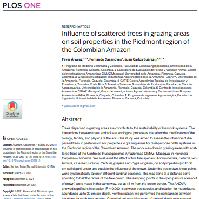Resumen
- Trees dispersed in grazing areas are contribute to the sustainability of livestock systems. The interactions between trees and soil are ecological processes that allow the modification of the biology, fertility, and physics of the soil. This study was aimed to assess the influence of dispersed trees in pastures on soil properties in grazing areas for dual-purpose cattle systems in the Piedmont region of the Colombian Amazon. The work was done in grazing areas with scattered trees at the Centro de Investigaciones Amazónicas CIMAZ–Macagual in Florencia—Caquetá—Colombia. We evaluated the effect of five tree species, Andira inermis, Bellucia pentámera, Guarea Guidonia, Psidium guajava and Zygia longifolia, on soil properties (up to 30 cm soil depth) under and outside the influence of the crown. Under the tree crown, three points were systematically taken in different cardinal positions. This was done at a distance corresponding to half the radius of the tree crown. The sampling points in the open pasture area (out of crown) were made in the same way, but at 15 m from the crown border. The ANOVA showed significant interaction (P < 0.0001) between tree species and location for macrofauna abundance up to 30 cm soil depth. For this reason, we performed the comparison between locations for each tree species. Chemical soil variables up to 10 cm soil depth only showed interaction of tree species-location for exchangeable potassium (P = 0.0004). Soil physical soil characteristics up to 30 cm soil depth only showed interaction of tree species-location at 20 cm soil depth (P = 0.0003). The principal component analysis for soil properties explained 61.1% of the total variability of the data with the two first axes. Using Monte Carlo test, we found crown effect for all species. Trees help to control exchangeable mineral elements that can affect the soil, potentiate basic cations such as magnesium and potassium, increase the abundance of soil macrofauna; but some trees with high ground level of shade in grazing areas could increase soil compaction due to the greater concentration of cattle in these areas.
